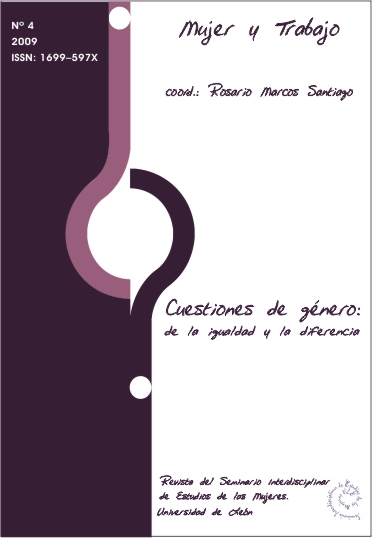Gender, employment and maternity: comparative analysis of women with paid work and housewives
DOI:
https://doi.org/10.18002/cg.v0i4.3813Keywords:
maternidad intensiva, roles familiares tradicionales, madres empleadas, familias de doble empleo, intensive mothering ideology, traditional family roles, working mothers, dual-earner familiesAbstract
The number of couples in which both partners have a job, and must balance work and family roles, has increased dramatically over the past thirty years. In Spain as in other western countries the number of women who continue in their employment when they marry and have children, has been steadily increasing. This change has brought a decrease in the woman´s presence at home and a reorganization of the traditional family roles and relationships for both women and men. Although changes in women activity may be studied through their employment rate, type of employment and drop out of the labor market, it is much more difficult to study changes in family gender roles and family relationships. This article will examine women´s and in particular mother´s employment, taking into account the sociological patterns and the ideological context in which it occurs and its relationship with family dynamics. Finally, it will be presented an empirical research comparing mothers who are employed and mothers who are not in some relevant family and individual areas.
Downloads
Métricas alternativas
References
Achenbach, T.M., y Edelbrock, C.S. (1983): Manual for the Child Behavior Checklist and Revised Child Behavior Profile. Burlington, VT: University of Vermont Department of Psychiatry.
Alberdi, I. (1999): La nueva familia española. Madrid: Taurus.
Aliaga, C. (2005): Gender gaps in the reconciliation between work and family life. En Statistics in focus: Population and Social Conditions, 4/2005. Disponible en: http://epp.eurostat.ec.europa.eu/cache/ITY_OFFPUB/KS-NK-05-004/EN/KS-NK-05-
-EN.PDF [01/01/2009].
Arendell, T. (2000): Conceiving and investigating motherhood: the decade´s scholarship. En Journal of Marriage & the Family, 62, pp. 1192-1207.
Belsky, J. (1990): Developmental risks associated with infant day care: attachment insecurity, noncompliance, and aggression? En S. Chehrazi (ed.) Psychosocial Issues in day care. Washington, DC: American Psychiatry Press.
Berry, J. (2006): Parental Stress Scale. Disponible en: http://www.personal.utulsa.edu/~judy-berry/parent.htm [01/01/2009].
Berry, J.O. y Jones, W.H. (1995): The Parental Stress Scale: Initial psychometric evidence. En Journal of Social and Personal Relationships, 12, pp. 463-472.
Castles, F.G. (2003): The world turned upside down: below replacement fertility, changing preferences and family-friendly public policy in 21 OECD countries. En Journal of European Social Policy, 13, pp. 209-227.
Clarke-Stewart, K.A. (1989): Infant day care, maligned or malignant?. En American Psychologist, 44, pp. 266-273.
Dribe, M., Stanfords, M. (2009): Does parenthood strengthen a traditional household division of labor?. Evidence from Sweden. En Journal of Marriage and Family, 71, pp. 33-45.
Esping-Andersen, G. (1999): Social foundations of postindustrial economies. Oxford, Oxford University Press.
Fundación Encuentro (2004): Informe España 2004. Una interpretación de su realidad social.
Madrid: Fundación Encuentro.
Gottfried, A.E., Gottfried, A.W. y Bathurst, K. (1995): Maternal and dual-earner employment status and parenting. En M.H. Bornstein (Ed): Handbook of parenting (vol.II). New Jersey: LEA.
Hays, S. (1998): Las contradicciones culturales de la maternidad. Barcelona: Paidós.
Hoffman, L.W. (2003): The effects of the mother´s employment on the family and the child. Disponible en: http://www.parenthood.library.wisc.edu/Hoffman/Hoffman.html [01/01/2009].
Hoffman,L.W., y Youngblade, L.M. (1999): Mothers at work. Effect on children´s well-being. New York: Cambridge University Press.
Instituto de la Mujer (2005): Conciliación de la vida familiar y la vida laboral: situación actual, necesidades y demandas. Madrid: Instituto de la Mujer.
Instituto de la Mujer (2008a): Las mujeres en España. Estadísticas de población
ocupada. Disponible en: http//www.migualdad.es/mujer/mujeres/cifras/empleo/poblacion_ocupada.htm [01/01/2009].
Instituto de la Mujer (2008b): Las mujeres en cifras. 1983-2008. Madrid: Instituto de la Mujer. Disponible en: http://www.migualdad.es/noticias/pdf/Mujeresencifras.pdf [01/01/2009].
Irvine, A.B., Biglan, A., Smolkowski, K., Ary, D. V. (1999): The value of the Parenting Scale for measuring the discipline practices of parents of middle school children. En Journal of Behaviour Research and Therapy, 37, pp. 127-142.
Johnson, C. L. y Johnson, F. A. (1977): Attitudes toward parenting in dual-career families. En American Journal of Psychiatry, 31, pp. 391-395.
MacCoby, E., Martin, J.A. (1983): Socialization in the context of the family : parentchild interactions. En E.M. Hetherington y P.H. Mussen (Eds): Handbook of child psychology. Nueva York: Wiley.
Martínez Díaz, M.P. (2005): El papel de las relaciones familiares en el ajuste familiatrabajo. En M.J. Carrasco y A. García-Mina, El ajuste trabajo-familia desde una perspectiva de género. Madrid: Universidad Pontificia Comillas.
Martínez, M.P., Carrasco, M.J. y Aza, G. (2006): Familias de doble empleo: claves diferenciales entre mujeres y varones para un modelo de conciliación de lo personal, familiar y social. Investigación no publicada, Instituto de la Mujer. Disponible en:
http://www.migualdad.es/mujer/mujeres/estud_inves/2007/resumen%20web774.pdf [01/01/2009].
Montoro Romero, R. (2000): El papel social y económico de las familias en la configuración del bienestar social. En Dimensiones económicas y sociales de la familia. Madrid: Fundación Argentaria y Visor.
Moreno, A. (2000): Los debates sobre la maternidad. En C. Fernández-Montraveta, P.
Monreal, A. Moreno y P. Soto. Las representaciones de la Maternidad. Madrid: Universidad Autónoma de Madrid.
Musitu, G. (1995): Familia, identidad y valores. En Infancia y Sociedad, 30, pp. 229- 262.
NICHD Early Child Care Research Network (2003): Does amount of time spent in child care predict socioemotional adjustment during the transition to kindergarten? En: Child Development, 74, pp.976-1005.
NICHD Early Child Care Research Network (2005): Child care and child development. New York: The Guilford Press.
Palacios, J., Hidalgo, M.V. y Moreno, M.C. (2000): Familia y vida cotidiana. En M.J. Rodrigo y J. Palacios (Coords.) Familia y desarrollo humano. Madrid: Alianza.
Patterson, G.R. (1983): Stress: A change agent for family process. En N. Garmezy & M. Rutter (Eds.), Stress, coping, and development in children. New York: McGraw- Hill.
Prades, J. (2008, 12 de Septiembre): Solos en casa después del cole. En El País pp.32
Renk,K. Roberts, R. y Roddenberry, A. (2003): Mothers, fathers, gender roles and time parents spend with their children. En Sex Roles, 48, pp. 305-315.
Sardinero García, E., Pedreira Massa, J.L. y Muñiz, J. (1997): El cuestionario CBCL de Achenbach: Adaptación española y aplicaciones clínico-epidemiológicas. En Clínica y Salud, 8, pp. 447-480.
Snyder, D. (1989): Marital Satisfaction Inventory (MSI): (4º ed.): Los Angeles; Western Psychological Services.
Solé, C. y Perella, S. (2004): “Nuevas” expresiones de la maternidad. Las madres con carreras profesionales “exitosas”. Revista Española de Sociología (RES), 4, pp.67-92. Disponible en: http://www.fes-web.org/revista/archivos/res04/03.pdf. [01/01/2009].
Subirats, M (1993): El trabajo doméstico, nueva frontera para la igualdad. En L. Garrido y E. Gil Calvo (Eds) Estrategias familiares. Madrid: Alianza.
Tobío C. (2005): Mujeres que trabajan. Dilemas y estrategias, Madrid: Editorial Cátedra.
Tobío, C. (2002): Conciliación o contradicción: cómo hacen las madres trabajadoras. En Revista Española de Investigaciones sociológicas, 97: pp.155-186.
Webster-Stratton, C. (1990): Stress: A potential disruptor of parent perceptions and family interactions. En Journal of Clinical Child Psychology, 19, pp. 302-312.
Downloads
Published
How to Cite
Issue
Section
License
Copyright (c) 2009 Pilar Martínez, María José Carrasco, Gonzalo Aza, Isabel Espinar, Ángeles Blanco

This work is licensed under a Creative Commons Attribution-NonCommercial-ShareAlike 4.0 International License.
L@s autores/as que publican en esta revista están de acuerdo con los siguientes términos:
1. L@s autores/as ceden de forma no exclusiva los derechos de explotación (reproducción, distribución, comunicación pública, transformación) a la Universidad de León, por lo que pueden establecer, por separado, acuerdos adicionales para la distribución no exclusiva de la versión de la obra publicada en la revista (por ejemplo, alojarlo en un repositorio institucional o publicarlo en un libro), con un reconocimiento de su publicación inicial en esta revista.
2. Este trabajo se encuentra bajo la Creative Commons Attribution-NonCommercial-ShareAlike 4.0 International License. Puede consultarse desde aquí la versión informativa y el texto legal de la licencia.
3. Se permite y se anima a l@s autores/as a difundir electrónicamente las versiones pre-print (versión antes de ser evaluada) y/o post-print (versión evaluada y aceptada para su publicación) de sus obras antes de su publicación, ya que favorece su circulación y difusión más temprana y con ello un posible aumento en su citación y alcance entre la comunidad académica.
Cuestiones de Género utiliza exclusivamente la licencia Atribución-NoComercial-CompartirIgual 4.0 Internacional (CC BY- NC-SA 4.0).
Bajo los siguientes términos:
- Atribución: Usted debe dar crédito de manera adecuada , brindar un enlace a la licencia, e indicar si se han realizado cambios . Puede hacerlo en cualquier forma razonable, pero no de forma tal que sugiera que usted o su uso tienen el apoyo de la licenciante.
- No Comercial: Usted no puede hacer uso del material con propósitos comerciales .
- Compartir Igual: Si remezcla, transforma o crea a partir del material, debe distribuir su contribución bajo la la misma licencia del original. cualquier uso permitido por la licencia.
No hay restricciones adicionales — No puede aplicar términos legales ni medidas tecnológicas que restrinjan legalmente a otras a hacer
L@s autores/as pueden consultar los derechos de copyright y las condiciones de autoarchivo en el directorio Dulcinea.










